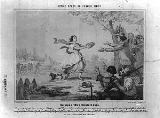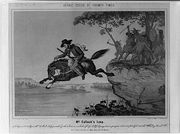
Fort Fincastle
Encyclopedia
- For the fort at the falls of the Appomatox River in Virginia, see Fort Henry (Virginia)Fort Henry (Virginia)Fort Henry was an English frontier fort in 17th century colonial Virginia near the falls of the Appomattox River. Its exact location has been debated, but the most popular one is on a bluff about four blocks north of the corner of W. Washington and N...
.
Fort Henry was a fort
Fortification
Fortifications are military constructions and buildings designed for defence in warfare and military bases. Humans have constructed defensive works for many thousands of years, in a variety of increasingly complex designs...
which stood about ¼ mile from the Ohio River
Ohio River
The Ohio River is the largest tributary, by volume, of the Mississippi River. At the confluence, the Ohio is even bigger than the Mississippi and, thus, is hydrologically the main stream of the whole river system, including the Allegheny River further upstream...
where the town of Wheeling
Wheeling, West Virginia
Wheeling is a city in Ohio and Marshall counties in the U.S. state of West Virginia; it is the county seat of Ohio County. Wheeling is the principal city of the Wheeling Metropolitan Statistical Area...
, West Virginia
West Virginia
West Virginia is a state in the Appalachian and Southeastern regions of the United States, bordered by Virginia to the southeast, Kentucky to the southwest, Ohio to the northwest, Pennsylvania to the northeast and Maryland to the east...
is now located. The fort was originally known as Fort Fincastle and was named for Viscount Fincastle, Lord Dunmore, Royal Governor of Virginia. Later it was renamed for Patrick Henry, and was at the time located in Virginia
Virginia
The Commonwealth of Virginia , is a U.S. state on the Atlantic Coast of the Southern United States. Virginia is nicknamed the "Old Dominion" and sometimes the "Mother of Presidents" after the eight U.S. presidents born there...
. The fort was subject to two major sieges, two notable feats (McColloch's Leap
McColloch's Leap
McColloch's Leap was a feat performed during a September 1777 attack by Native Americans on Fort Henry, site of present-day Wheeling, West Virginia, during the American Revolutionary War....
and Betty Zane
Betty Zane
Elizabeth "Betty" Zane McLaughlin Clark was a heroine of the Revolutionary War on the American frontier. She was the daughter of William Andrew Zane and Nancy Ann Zane, and the sister of Ebenezer Zane, Silas Zane, Jonathan Zane, Isaac Zane and Andrew Zane...
's trek through the battle) and other skirmishes.
History
Built in June 1774, Fort Henry was not erected by any specific plan or design, but was one of a number of similar forts built to protect settlers on the frontier in the middle years of the 1770s. The outbreak of the Shawnee (tribe) or Dunmore's WarDunmore's War
Dunmore's War was a war in 1774 between the Colony of Virginia and the Shawnee and Mingo American Indian nations....
, a conflict between American Indians of the Ohio Country
Ohio Country
The Ohio Country was the name used in the 18th century for the regions of North America west of the Appalachian Mountains and in the region of the upper Ohio River south of Lake Erie...
and Virginia, was the immediate reason for its construction.
Construction was supervised by Colonel William Crawford
William Crawford (soldier)
William Crawford was an American soldier and surveyor who worked as a western land agent for George Washington. Crawford fought in the French and Indian War and the American Revolutionary War...
under the orders of the Royal Governor of Virginia, Lord Dunmore
John Murray, 4th Earl of Dunmore
John Murray, 4th Earl of Dunmore was a British peer and colonial governor. He was the son of William Murray, 3rd Earl of Dunmore, and his wife Catherine . He is best remembered as the last royal governor of the Colony of Virginia.John was the eldest son of William and Catherine Murray, and nephew...
.
It would appear that the need for a fortified shelter was noticed simultaneously by the residents of the area, and by the military authorities at Fort Pitt (Pennsylvania)
Fort Pitt (Pennsylvania)
Fort Pitt was a fort built at the location of Pittsburgh, Allegheny County, Pennsylvania.-French and Indian War:The fort was built from 1759 to 1761 during the French and Indian War , next to the site of former Fort Duquesne, at the confluence the Allegheny River and the Monongahela River...
, in the Spring of 1774. John Connally
John Connally
John Bowden Connally, Jr. , was an influential American politician, serving as the 39th governor of Texas, Secretary of the Navy under President John F. Kennedy, and as Secretary of the Treasury under President Richard M. Nixon. While he was Governor in 1963, Connally was a passenger in the car in...
wrote to Wheeling and urged the settlers to fortify themselves as soon as possible.
Ebenezer Zane
Ebenezer Zane
Ebenezer Zane was an American pioneer, road builder and land speculator. Born in what is now Moorefield, West Virginia , Zane established the settlement known as Fort Henry in Wheeling, Virginia on the Ohio River...
and John Caldwell began the fort, which was completed with the help of Captain William Crawford
William Crawford
William Crawford is the name of:* William Crawford , Scottish painter* William Crawford , Member of Parliament for Mid Durham, 1885–1890...
, Colonel Angus McDonald and 400 militia and regulars from Fort Pitt. A letter preserved in the Pennsylvania Archives shows that Connally told Crawford "to proceed to Wheeling and complete the fort."
A letter from Lord Dunmore dated June 20, 1774 to Connally states that Dunmore “entirely [approved] of the measures [Connally] have taken to build a fort at Wheeling." Dunmore, then, did not specifically order the fort to be built, but did approve of it. Connally, according to some accounts, left Fort Pitt with 100 men to help build the fort, but was harassed by a small raiding party of Indians. He returned to Fort Pitt, and then sent out Crawford and McDonald with 400 men.
Form
The fort enclosed about 0.5 acres (2,023.4 m²) and was defended on three sides by the topography. On the south and west (river) sides, the bluff prevented or greatly hindered assaults. On the north, the ravine provided protection. The only level ingress would have been from the east. Zane's blockhouseBlockhouse
In military science, a blockhouse is a small, isolated fort in the form of a single building. It serves as a defensive strong point against any enemy that does not possess siege equipment or, in modern times, artillery...
protected the entrance since attackers had to pass by it to attack the fort. They would have been caught in a crossfire between the fort and the blockhouse. All of the recorded attacks on Fort Henry came from the east.
The outer palisade
Palisade
A palisade is a steel or wooden fence or wall of variable height, usually used as a defensive structure.- Typical construction :Typical construction consisted of small or mid sized tree trunks aligned vertically, with no spacing in between. The trunks were sharpened or pointed at the top, and were...
wall was made of timber
Timber
Timber may refer to:* Timber, a term common in the United Kingdom and Australia for wood materials * Timber, Oregon, an unincorporated community in the U.S...
s, with blockhouses built at each of the four corners. In 1781 a two-story log structure was added near the front gate on which a cannon was mounted.
Battles

American Revolutionary War
The American Revolutionary War , the American War of Independence, or simply the Revolutionary War, began as a war between the Kingdom of Great Britain and thirteen British colonies in North America, and ended in a global war between several European great powers.The war was the result of the...
, once
Siege of Fort Henry (1777)
The Siege of Fort Henry was an attack on American militiamen during the American Revolutionary War near the Virginia outpost known as Fort Henry by a mixed band of Indians in September 1777...
in 1777 and again
Siege of Fort Henry (1782)
The Siege of Fort Henry was an assault on the American Fort Henry, a frontier fort on the western reaches of Virginia that is now the site of Wheeling, West Virginia...
in 1782.
In 1777, Native American of the Shawnee
Shawnee
The Shawnee, Shaawanwaki, Shaawanooki and Shaawanowi lenaweeki, are an Algonquian-speaking people native to North America. Historically they inhabited the areas of Ohio, Virginia, West Virginia, Western Maryland, Kentucky, Indiana, and Pennsylvania...
, Wyandot and Mingo
Mingo
The Mingo are an Iroquoian group of Native Americans made up of peoples who migrated west to the Ohio Country in the mid-eighteenth century. Anglo-Americans called these migrants mingos, a corruption of mingwe, an Eastern Algonquian name for Iroquoian-language groups in general. Mingos have also...
tribes joined to attack settlements along the Ohio River
Ohio River
The Ohio River is the largest tributary, by volume, of the Mississippi River. At the confluence, the Ohio is even bigger than the Mississippi and, thus, is hydrologically the main stream of the whole river system, including the Allegheny River further upstream...
. Local men later joined by recruits from Fort Shepherd (in Elm Grove) and Fort Holliday defended the fort. The native force subsequently burned the surrounding cabins and destroyed livestock. Major Samuel McColloch led a small force of men from Fort Vanmetre along Short Creek
Short Creek, West Virginia
Short Creek is an unincorporated town in Brooke County, West Virginia, USA. It also includes the dwellings along the creek from the Bottom of Dean's Hill and the Bottom of West Liberty Hill to the mouth of Short Creek at the Ohio River....
to assist the besieged Fort Henry. McColloch was separated from his men and was chased by attacking Indians. Upon his horse, McColloch charged up Wheeling Hill and made what is known as McColloch's Leap
McColloch's Leap
McColloch's Leap was a feat performed during a September 1777 attack by Native Americans on Fort Henry, site of present-day Wheeling, West Virginia, during the American Revolutionary War....
300 feet (91.4 m) down its eastern side to safety. The Indians rushed to the edge, expecting to see the Major lying dead in a crumpled heap at the bottom of the hill. To their great surprise they instead saw McColloch, still mounted on his white horse, galloping away from them.
In 1782, a native army along with some British soldiers attempted to take Fort Henry. During this siege, Fort Henry's supply of ammunition was exhausted. The defenders decided to dispatch one of its men to secure more ammunition from the Zane homestead. Betty Zane
Betty Zane
Elizabeth "Betty" Zane McLaughlin Clark was a heroine of the Revolutionary War on the American frontier. She was the daughter of William Andrew Zane and Nancy Ann Zane, and the sister of Ebenezer Zane, Silas Zane, Jonathan Zane, Isaac Zane and Andrew Zane...
volunteered for the dangerous task. During her departing run, she was heckled by both native and British soldiers. Upon successfully reaching the Zane homestead, she gathered a table cloth and filled it with gunpowder. During her return, she was fired upon but was uninjured. It is believed that one bullet did, in fact, pierce her clothing. As a result of Zane's heroism, Fort Henry remained in American control.
Numerous other skirmishes took place nearby.

